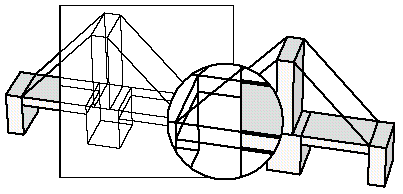Magic Lens

[Bier et al., 1993]
Magic Lens™ filters are new a user interface tool that combine an arbitrarily-shaped region with an operator that changes the view of objects viewed through that region.
[Stone et al, 1994]
The notion of the Magic Lens was introduced in Toolglass and Magic Lenses by Eric Bier et. al., and a similar idea was presented as the Portal Filter in Perlin and Fox’s paper from the same conference. A Magic Lens is a transparent or semi-transparent user interface element which can be placed over objects to change their appearance and/or their interactive behavior
[Fox, 1998]
Magic lenses allow to select a arbitrarily shaped area of an object and to manipulate this area with specific operators. Magic lenses can be moved like ordinary lenses. One of their advantages is that they cover only a part of the object; this part is shown with the effect applied. Finally, the user can apply this effect to a part or to the whole object.
[Waloszek, 2004]
Showing a modified view of the selected region of interest while leaving the rest of the visualization unchanged, these tools extend the metaphor of a magnifying glass to include any sort of useful visual transformation of application data. They can be used to help the user understand various types of information, from text documents to scientific visualizations.
External Links
- The Magic Lens Interface Project Eric Bier, Ken Fishkin, Ken Pier, Maureen Stone (Xerox Parc)
- Tominski, C.; Gladisch, S.; Kister, U.; Dachselt, R. & Schumann, H.: A Survey on Interactive Lenses in Visualization. EuroVis State-of-the-Art Reports, Eurographics Association, 2014. (to appear)
References
- [Bier et al., 1993] Eric A. Bier, Maureen C. Stone, Ken Pier, William Buxton, Tony D. DeRose. Toolglass and Magic Lenses: The See-Through Interface. Proceedings of SIGGRAPH '93, 1993.
- [Fox, 1998]: David Fox, Composing Magic Lenses, Proceedings of the SIGCHI conference on Human factors in computing systems (CHI '98), p. 519-525, 1998.
- [Stone et al, 1994]: Maureen C.Stone, Ken Fishkin, Eric A Bier, The Movable Filter as a User Interface Tool, Proceedings of the SIGCHI conference on Human factors in computing systems (CHI '94), p. 306-312, 1994.
- [Viega et al, 1996]: John Viega, Matthew J. Conway, George Williams, and Randy Pausch, 3D magic Lenses, Proceedings of the 9th annual ACM symposium on User interface software and technology, p. 51-58, 1996.
- [Waloszek, 2004] G. Waloszek, Magic Lens, Created at: January 13, 2004. Retrieved at: November 2004. http://www.sapdesignguild.org/community/book_people/visualization/controls/MagicLens.htm